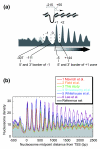A compiled and systematic reference map of nucleosome positions across the Saccharomyces cerevisiae genome
- PMID: 19814794
- PMCID: PMC2784324
- DOI: 10.1186/gb-2009-10-10-r109
A compiled and systematic reference map of nucleosome positions across the Saccharomyces cerevisiae genome
Abstract
Nucleosomes have position-specific functions in controlling gene expression. A complete systematic genome-wide reference map of absolute and relative nucleosome positions is needed to minimize potential confusion when referring to the function of individual nucleosomes (or nucleosome-free regions) across datasets. We compiled six high-resolution genome-wide maps of Saccharomyces cerevisiae nucleosome positions from multiple labs and detection platforms, and report new insights. Data downloads, reference position assignment software, queries, and a visualization browser are available online http://atlas.bx.psu.edu/.
Figures




References
Publication types
MeSH terms
Substances
Grants and funding
LinkOut - more resources
Full Text Sources
Molecular Biology Databases

